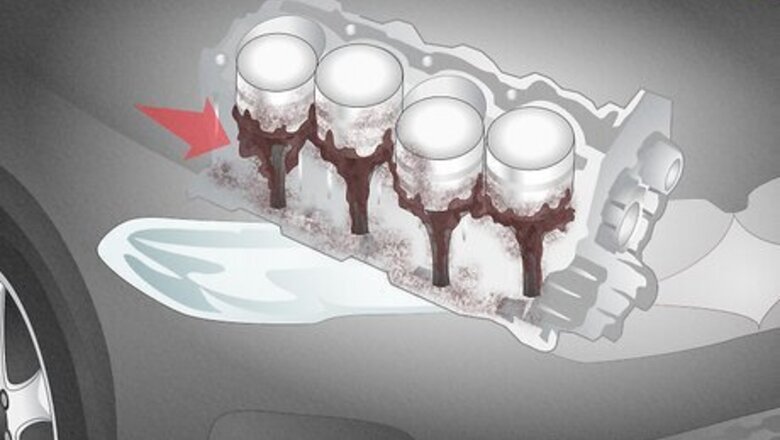
views
- Sludge is created by oxidized oil. Since oil lines are closed systems, sludge indicates you have a leak somewhere.
- Prevent sludge by changing your oil regularly, swapping out your oil filter once a year, and avoiding short trips with your vehicle.
- See a mechanic to have your oil lines inspected for leaks and to get a fresh oil change.
What is engine sludge?
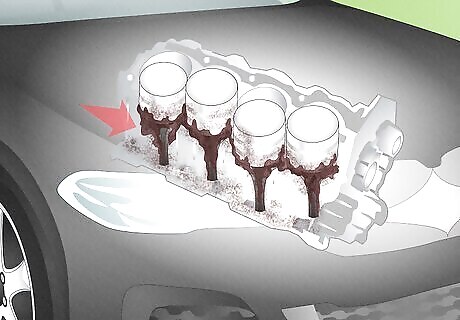
Sludge is oxidized oil that turns into a gelatinous material. Your engine oil is normally a closed system. The oil goes through the engine to lubricate it, passes through a filter to remove any debris and then cycles back through the pump and engine again. If there’s a leak anywhere where air can get in, that oil oxidizes. That creates a chain reaction that produces sludge—a thick, Jello-like substance that won’t flow freely the way oil should. Sludge is a major problem for two reasons. First, sludge is super thick so it can block up valves and restrict oil flow. Second, sludge only develops if you have a leak somewhere to let air into the oil lines, so you’ve definitely got a leak to fix somewhere. So what causes engine sludge? Sludge only occurs when you have an oil leak or very old engine oil that has been exposed to the air for a prolonged period of time (i.e. the car was sitting on cinderblocks with the oil cap off).
Symptoms of Engine Sludge
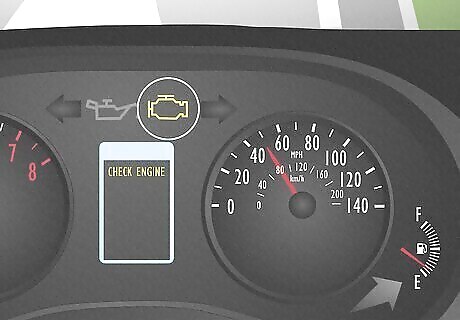
Engine sludge can cause bad fuel mileage and oil pressure issues. Engine sludge is actually a symptom—it’s caused by oil line leaks and old oil—but this symptom can create additional problems on its own. These issues include: Poor engine performance and fuel mileage. Oil pressure warning or check engine lights. Inconsistent oil pressure readings on the gauge. Engine overheating.
Identifying Engine Sludge

Crank the engine and look for a check engine or oil change light. With a cold engine, go to the car and crank the engine with the key to start the vehicle. Inspect your dashboard before you get out of the car to look for error lights. If you see a check engine or oil change light, it’s a good sign you may have an issue with sludge. A car with an oil change light on is not safe to drive if the oil pressure is low. Without lubrication, the engine becomes a serious fire risk.
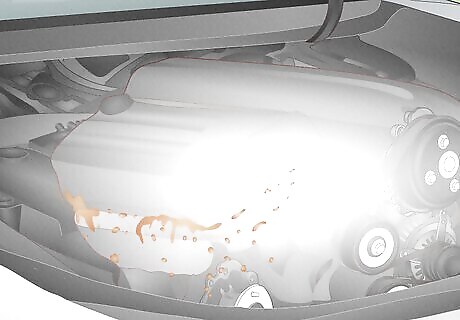
Pop the hood and look for oil splatter in the engine bay. Turn the car off and pop the hood. Inspect the engine bay carefully and look at the underside of the hood. If you see any oil splatters, oil bubbles appearing around any valves or gaskets, or fresh oil drips, the grime on your vehicle is probably sludge. If you don’t see any gelatin-like material anywhere, you probably don’t have an engine sludge problem. It’s extremely rare for sludge to build up inside oil lines but not appear anywhere on top of the engine components.

Open the oil cap and inspect the inside of the pan for sludge. Grab a flashlight and open the cap of the oil pan (the one in your engine bay—not the drain valve under the vehicle). Shine a flashlight inside to carefully inspect the walls of the container. If you can see the shiny silver walls even a little bit, you’re good. If the entire container is caked in a thick layer of gunk, you’ve got a sludge problem. If you recently refilled the oil, there may not be enough room for you to spot the sides of the container. In that case, check the dipstick. If there’s thick gunk on the dipstick, you probably have a sludge problem. It’s okay if the walls of the container look slick from the oil—it only matters if you can’t see the shiny walls at all. If you have sludge inside the reservoir but not anyone visible in the engine bay, it’s just a big sign you need an oil change.
Treating Engine Sludge
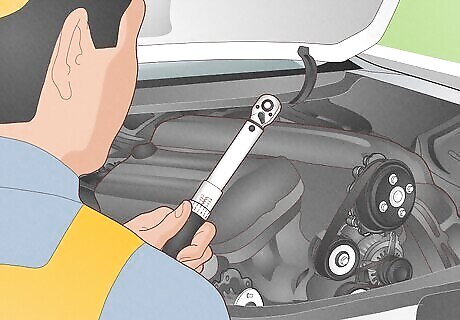
See a mechanic to have your engine cleaned and inspected. Sludge is a sign that you need an oil change, but it’s also a sign that you’ve got a leak somewhere. See a mechanic to have your oil changed, your filter inspected, and any leaks patched. They’ll also clean any visible sludge buildup in your engine bay. You can change your own oil if you’d like, but it is highly recommended that you see a mechanic to address the leak. The air is getting into your oil lines somehow, and finding the issue under the sludge can be quite difficult.

Add a specialized detergent to your engine oil. Most modern oil manufacturers will automatically add buildup detergent to their oil. However, ask your mechanic if they think you’d benefit from adding an additional detergent formula to your oil tank. These oil treatment cleaners can help prevent sludge buildup inside of your oil lines. Most mechanics agree that these additives are probably unnecessary in most modern vehicles using synthetic oil. However, you may have unique needs based on the age of your vehicle and its overall wear and tear.
Preventing Engine Sludge

Get regular oil changes. Over time, your oil picks up all kinds of microscopic debris and junk. The heat and churn from your engine also break the oil down. If you don’t change the oil out when that happens, the odds you spur a leak and develop sludge increase. Get your oil changed every 5,000 miles (8,000 km) or once a year—whatever happens first. If your vehicle is more than 20 years old or so, get an oil change every 3,000 miles (4,800 km) or so.

Replace your oil filter yearly. At least once a year, ask your mechanic to swap out your filter when you’re getting the oil changed. The oil filter is responsible for absorbing all of the gunk in the oil as it cycles through the engine. But if the filter never gets changed, it can create a pressure imbalance in the oil lines, which can create leaks that let air in. There’s a lot of debate about how often you need to get your filter changed, but doing it at least once year should be more than enough.

Switch to a synthetic oil. Refer to your manual and look at the cap on your engine oil reservoir to determine if your engine can handle synthetic oil. If it can and you’ve been using conventional oil, make the change to the synthetic stuff. Synthetic oil is better for your engine and less likely to convert into sludge if it’s exposed to air. Synthetic oil typically has a lower viscosity, which means it flows more easily than the conventional stuff.

Walk or bike instead of driving short distances. If you have to go 5 miles (8.0 km) or less, don’t drive unless you have to. These short trips are especially bad for the health of your engine because the oil doesn’t really have time to “warm up” and remove debris in your oil lines. Also, you spark combustion every time you start the vehicle, so starting and shutting the engine off frequently puts unnecessary wear and tear on your engine. This is even more problematic if you’re making these short trips in very hot or cold weather. Extreme temperatures make short trips even harder for engines.
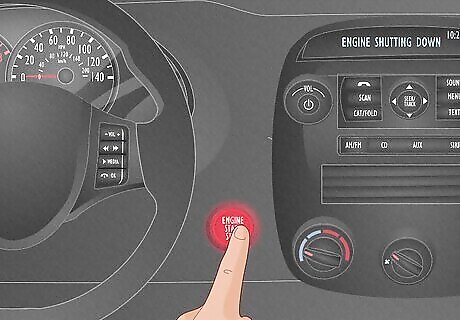
Shut your engine off if you’re idling for long periods of time. Letting your engine run idly without actually driving cycles the oil through your vehicle. But since the pistons aren’t firing at more than a slow clip, the oil never gets as hot as it’s designed to. This leads to a lot of residue inside of your oil lines as none of it burns away. It’s okay to idle if you’re going to get out of the car and hop back in or if it’s especially cold out while you’re waiting for someone, but it’s better to shut the engine off and turn it back on if you’re waiting more than 30 seconds or so.

















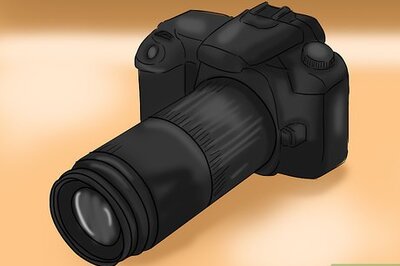

Comments
0 comment